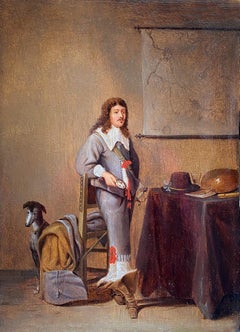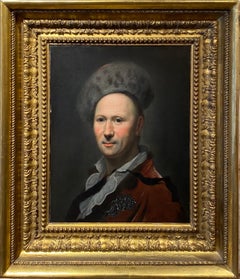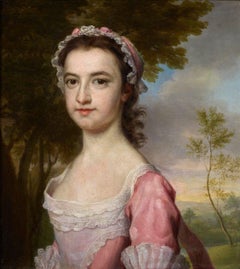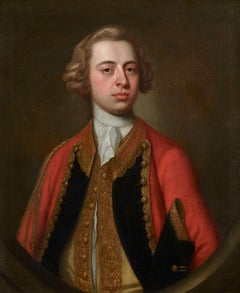Want more images or videos?
Request additional images or videos from the seller
1 of 2
Portrait of a Lady
$33,086.67List Price
About the Item
- Attributed to:Barthel Bruyn. (1493 - 1555, German)
- Dimensions:Height: 10 in (25.4 cm)Diameter: 0.5 in (1.27 cm)
- Medium:
- Movement & Style:
- Period:
- Condition:
- Gallery Location:London, GB
- Reference Number:1stDibs: LU5248126482
About the Seller
5.0
Vetted Professional Seller
Every seller passes strict standards for authenticity and reliability
Established in 2007
1stDibs seller since 2014
82 sales on 1stDibs
Typical response time: 4 hours
Authenticity Guarantee
In the unlikely event there’s an issue with an item’s authenticity, contact us within 1 year for a full refund. DetailsMoney-Back Guarantee
If your item is not as described, is damaged in transit, or does not arrive, contact us within 7 days for a full refund. Details24-Hour Cancellation
You have a 24-hour grace period in which to reconsider your purchase, with no questions asked.Vetted Professional Sellers
Our world-class sellers must adhere to strict standards for service and quality, maintaining the integrity of our listings.Price-Match Guarantee
If you find that a seller listed the same item for a lower price elsewhere, we’ll match it.Trusted Global Delivery
Our best-in-class carrier network provides specialized shipping options worldwide, including custom delivery.You May Also Like
Portrait of Lady Caroline Price
By George Romney
Located in Miami, FL
DESCRIPTION: Perhaps the best Romney in private hands. If Vogue Magazine existed in the late 18th century, this image of Lady Caroline Price would be ...
Category
1970s Old Masters Portrait Paintings
Materials
Oil, Canvas
Angelic Cherubs with Classical Figure in Wilderness Finely Painted Preparatory
Located in Cirencester, Gloucestershire
Figure with Cherubim in Wilderness
Italian School, 17th century
oil painting on wood panel
framed 13 x 11 inches
condition: overall for its age very good, though the work is most likely a preparatory...
Category
17th Century Old Masters Figurative Paintings
Materials
Oil, Wood Panel
$3,570
H 13 in W 11 in D 1 in
French Old Master The Garden of Gethsemane Unusual Shape Panel
Located in Cirencester, Gloucestershire
Artist/ School: French School, 18th century
Title: The Garden of Gethsemane
Medium: oil painting on wooden panel, unframed.
painting: measurem...
Category
18th Century Old Masters Figurative Paintings
Materials
Oil
Fine Antique Classical Nude Draped in Robes Dancing with Dog Gold Background
Located in Cirencester, Gloucestershire
Artist/ School: Italian School, 19th century
Title: Classical nude draped in robes with dancing dog. The work looks as though it might have been a ceiling...
Category
19th Century Old Masters Nude Paintings
Materials
Oil, Canvas
Mary & Jesus, 18th Century French Old Master oil painting on canvas
Located in Cirencester, Gloucestershire
Artist/ School: French School, 18th century
Title: Mary and Jesus
Medium: oil on canvas, framed
Framed: 17 x 14.5 inches
Canvas: 16 x 12.75 inches
Provenance: private collection...
Category
18th Century Old Masters Figurative Paintings
Materials
Oil
1600's Flemish Old Master Oil Painting The Virgin & Child Mastertpiece Work
Located in Cirencester, Gloucestershire
The Virgin & Child
Flemish School, circa 1600
circle of Cornelis van Cleve (Flemish c. 1520-1614),
oil painting on canvas
canvas: 37 x 30 inches
provenance: private collection, Paris...
Category
Early 17th Century Old Masters Portrait Paintings
Materials
Canvas, Oil
$11,259
H 44 in W 36 in D 1 in
Fine 18th Century English Portrait of Aristocratic Gentleman Huge Oil Painting
Located in Cirencester, Gloucestershire
Portrait of an Aristocratic English Gentleman
circle of Thomas Hudson (British (1701-1779)
oil on canvas, framed
framed: 53.5 x 45 inches
painting: 45 x 40 inches
provenance: private...
Category
18th Century Old Masters Portrait Paintings
Materials
Oil
$4,119
H 53.5 in W 45 in
Fine Large 17th/ 18th Century English Portrait of Mr. Gilbert Charity Founder
Located in Cirencester, Gloucestershire
Portrait of Mr. Gilbert (believed to be the founder of 'Gilberts Charity, Bridgwater, Somerset)
English School artist, late 17th/ early 18th century
oil...
Category
Late 17th Century Old Masters Portrait Paintings
Materials
Oil, Canvas
Large 17th Century Dutch Old Master Oil Painting on Wood Panel Biblical Scene
Located in Cirencester, Gloucestershire
Biblical Figures, Large Gathering around Christ?
Dutch Old Master, early 17th century
oil painting on wood panel, stuck on velvet backing board
velvet board: 27 x 29 inches
board: 25.5 x 26 inches
provenance: private collection, France
condition: good and sound condition, obvious old panel...
Category
Early 17th Century Old Masters Figurative Paintings
Materials
Oil, Wood Panel
Large 1700's Italian Oil Painting on Canvas Portrait of a Clerical Gentleman
Located in Cirencester, Gloucestershire
Portrait of a Clerical Gentleman
Italian artist, mid 18th century
Circle of Giovanni Battista Carboni (1725-1790)
oil on canvas, unframed
canvas: 26 x 22 inches
provenance: private c...
Category
Mid-18th Century Old Masters Portrait Paintings
Materials
Oil, Canvas
$1,373
H 26 in W 22 in
More From This Seller
View AllSoldier in an Interior, Early 17th Century Dutch Oil
Located in London, GB
Pieter Symonsz Potter
Dutch 1600 - 1652
Soldier in an Interior
Oil on oak panel, red seal to reverse
Image size: 15 x 10 3/4 inches
Dutch Ebonised frame
Bathed in a well lit roo...
Category
Early 17th Century Old Masters Portrait Paintings
Materials
Oil, Board
Portrait of Conrad Friedrich Hurlebusch, Early 18th Century Oil Painting
By Dominicus van der Smissen
Located in London, GB
Dominicus van der Smissen
Early 18th Century
Portrait of Conrad Friedrich Hurlebusch
Oil on canvas
Image size: 20½ x 16¼ inches
Period gilt frame
This is a portrait of Conrad Friedrich Hurlebusch, composer, Kapellmeister and organist, whom Van der Smissen most probably portrayed during his stay in Hamburg, Brunswick or Amsterdam. The identification is based on the reproduction of the portrait which was engraved by Pieter Anthony Wakkerdak (1740- 1774).
Van der Smissen has reduced the face of the sitters to an egg-shaped oval in three-quarter view, applying diminution to one half of the figure’s torso, which is farther away from the viewer. This partial side view, with the head turned to look at the viewer over the shoulder, creates spatial depth and brings the figure to life by avoiding the stiffness of a frontal depiction.
Because the artist chose to highlight the figure from above, a distinct shadow is cast under the tip of the nose, in the shape of a triangle. This is an often recurring and almost ‘signature’-like feature in Van der Smissen’s oeuvre.
Hurlebusch's garments are of a very high quality and serve to reflect the sitter’s wealth, status and elegance. During this period, gentlemen often shaved their heads in order to facilitate the wearing of a wig, which wouldbe worn with a suit. Here Hurlebusch has been depicted in a luxurious turban-like cap lined with lynx fur, a highly fashionable and expensive material at the time.
Over his shirt, he wears a velvet fur-lined gown adorned with decorative clasps fashioned from silver braid. The elegant informality of his appearance can be seen in his unbuttoned shirt and the unfastened black ribbon hanging from his button hole, which has been artfully arranged into a fluttering drape by the portraitist.
The Sitter
Hurlebusch was born in Brunswick, Germany. He received the first instructions in his field from his father Heinrich Lorenz Hurlebusch, who was also a musician. As an organ virtuoso, he toured Europe, visiting Vienna, Munich and Italy.
From 1723 to 1725 he was Kapellmeister in Stockholm; later he became Kapellmeister in Bayreuth and Brunswick, and lived in Hamburg from 1727 to 1742, where he had contact with fellow composers Johann Mattheson and Georg Philipp Telemann. He made his living composing, performing and teaching.
In 1735 and 1736, he is believed to have visited Johann Sebastian Bach in Leipzig, who promoted Hurlebusch’s compositions as the local seller...
Category
Early 18th Century Old Masters Portrait Paintings
Materials
Canvas, Oil
Portrait of a Girl, 18th Century Oil Old Master
By George Knapton
Located in London, GB
George Knapton
1698-1778
Portrait of a Girl
Oil on canvas
Image size: 20 x 18 inches
Original giltwood frame
This beautiful half length portrait of a young woman, turned to left, gazing at the spectator, wearing a pink, white lace-embroidered, dress, in her hair a pink bonnet trimmed with lace to match her dress.
The depiction of a young girl epitomises child portraiture of the late eighteenth century, in which painters such as William Beechey, Joshua Reynolds, Thomas Gainsborough had begun to discover and express the true character of children, in contrast to the stiff, miniature-adults of previous generations.
The Artist
Knapton was born in Lymington, one of four sons of James Knapton. He was apprenticed to Jonathan Richardson from 1715 to 1722, and in 1720 was a founding subscriber to the academy of St. Martin's Lane established by Louis Chéron...
Category
18th Century Old Masters Portrait Paintings
Materials
Canvas, Oil
Portrait of William Henry Kerr, Earl of Ancram, 4th Marquess of Lothian
Located in London, GB
James Fellowes
Flourished 1719 - 1750
Portrait of William Henry Kerr, Earl of Ancram, 4th Marquess of Lothian
Oil on canvas, signed & dated 1747
Image size: 29 1/2 x 24 1/2 inches (75 x 62 cm)
Original gilt wood frame
William Henry Kerr was born a member of the Scottish peerage to William, third Marquess of Lothian, and his first wife Margaret, daughter of Sir Thomas Nicholson of Kemnay, first Baronet. William was styled Master Jedburgh until 1722, when his father was elevated to a Marquessate, after which he was referred to as Lord Jedburgh until 1735. Following his father’s military footsteps, on 20 June 1735 Ancram was commissioned as a cornet to the regiment (11th Dragoons) of his grand-uncle, Lord Mark Kerr. Ancram married Lady Caroline...
Category
1740s Old Masters Portrait Paintings
Materials
Oil
Portrait of a Lady, 17th Century Flemish Oil Old Masters
By Jacob Huysmans
Located in London, GB
Jacob Huysmans
Flemish 1633 - 1696
Portrait of a Lady
Oil on canvas
Image size: 49 x 40 ¼ inches
Gilt frame
Huysmans was born in Antwerp and came to England during the reign of Charles II where he became one of the fashionable painters of the court.. The diarist Samual Pepys noted the artist as capable of a more exact likeness than Lely. Certainly the diarist records that by August 1664 in the circle of Queen Catherine...
Category
17th Century Old Masters Portrait Paintings
Materials
Canvas, Oil, Acrylic
Portrait of a Young Man - 17th Century Portrait in Oil
By Pieter Harmensz Verelst
Located in London, GB
Circle of Pieter Harmensz Verelst
1618 - 1678
Portrait of a Young Man
Oil on oak panel
Image size: 7 ½ x 5 ¾ inches
Dutch ripple frame
Category
18th Century and Earlier Old Masters Portrait Paintings
Materials
Oil, Panel



